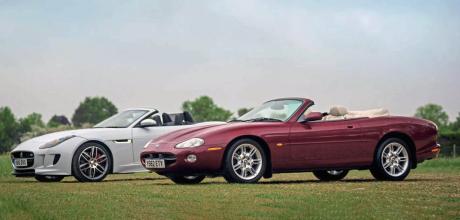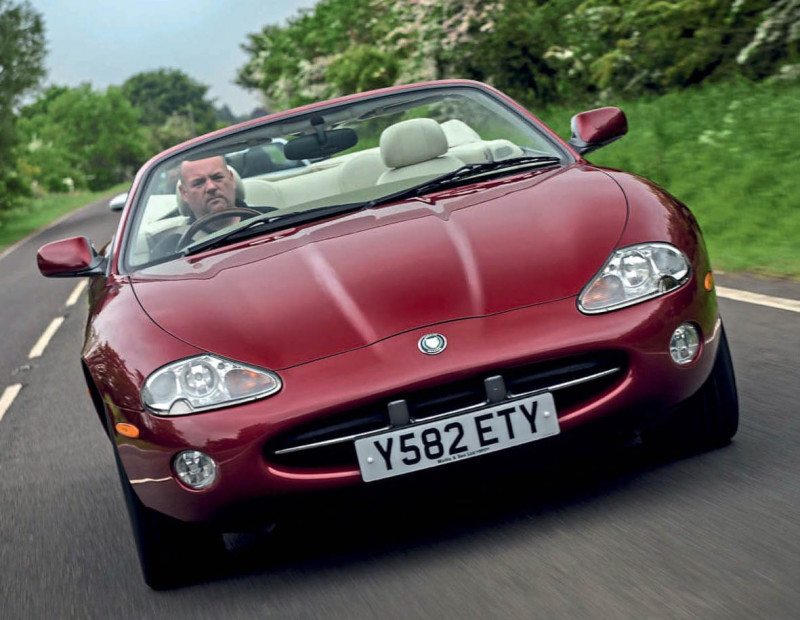Jaguar XK8 4.0 Convertible X100

The Jaguar XK8 X100 might be the most affordable here, but it’s still one of the best.
Cheap thrills
With summer finally here, there’s never been a better time to buy a convertible. We look at five of Jaguar’s finest from the last four decades that are also affordable

There’s a certain irony that the cheapest car on our list is the one that, thanks to its soft, swooping lines and oval grille, looks the most like the famous E-type. But then, that was always the point of the car. After 21 years of the more angular XJS, Jaguar’s designers felt it was time to return to the kind of looks the company was once famous for. In other words, a modern take on the E-type. “Internally, we had a very strong view that the XK8 ought to be the spiritual offspring of the E-type,” said Jaguar’s then design director, the late Geoff Lawson, in an interview in the 6 March 1996 issue of Autocar, “with muscular flowing shapes and a much sportier look than the XJS.”
He was spot on with his assessment since the new direction was widely praised by the critics with Car magazine describing it in the April 1996 issue as, “a curvaceous, elegant car.”
Over 25 years later and that’s still the case and I’d argue the XK8, especially the very early example featured here with its pure, unadulterated lines, is the prettiest of the five models assembled. Obviously it’s okay if you disagree – there are no bad-looking cars here – but compare the car with the overblown F-TYPE R on page 34 and you’ll get what I mean.

Other than the design, a new, all-aluminium, 32-valve 4.0-litre V8 was central to the car’s success. Developed in-house, it was produced at Ford’s engine plant in Bridgend, south Wales.
Although the all-steel XK8 convertible weighed a chunky 1,754kg (3,867lb), with the engine producing a healthy 290bhp, the car still performed as well as it looked with 60mph reached in 6.7 seconds and maxing out at 154mph. As Autocar said in its 2 October 1996 issue, “This is an engine that loves to rev, one that feels at its most comfortable when subjected to hard work, gathering momentum quickly from low revs, thanks to that wide spread of torque, but reserving its most inspired work for the final 2,000rpm at which point it emits a noise that is as glorious as it is sophisticated.”
Yet there’s no denying the XK8 was more of a grand tourer than an out-and-out performance car. To begin with, it was the first Jaguar sports model not to have the option of a manual gearbox, the only transmission available being a five-speed automatic sourced from German manufacturer, ZF. Plus, the interior was covered in thick veneer and rich leather, which although still makes it extremely comfortable, even in the mid-Nineties it looked and felt about as contemporary as a Queen Anne chair.
It handles more like a GT, too. As mentioned earlier, it’s quite heavy and thanks to overly supple suspension and fairly numb steering, it doesn’t attack corners in the same, confident way as the later all-aluminium XK or F-TYPE might. The pay-off, though, is a majestically supple ride that irons out the worst this country’s roads have to offer and potholes, that would jar the cabin of the aforementioned cars, would barely be felt in the XK8.
Amazingly, despite their looks, performance and rising interest in these cars, they remain great value for money. It’s still possible to buy an early XK8 4.0 convertible for as little as £5k although these will be high-mileage examples with a dubious history. The very best examples now go for over £10,000 which is still a steal compared to the high values of some of its predecessors.
If you want more power, then the supercharged XKR that was introduced in 1998 has 300bhp plus the stiffer computer active technology suspension (CATS) as standard. Together, these attributes made the XKR more of a performance car. Convertibles start at around £10,000 rising to £15,000.
No matter how much you pay or the condition of the car, the XK8 can suffer from several ailments, the most important being the plastic timing chain tensioners and guides snapping if they haven’t been replaced for steel ones from the later 4.2 V8. An absolute necessity, if this hasn’t been done, budget for around £1,500 at an independent specialist. The XK8’s other biggest issue is corrosion, especially the sills, front floor, rear wheelarches and front chassis legs. While new panels and parts are becoming available, it can still be expensive to put right and many XK8s have been lost recently due to excessive tin worm. Plus, with the oldest cars now being a quarter-of- a-century old, it’s not unusual for many of the sensors to fail, putting the car into limp mode. As an XK8 owner myself, I’ve lost count of how many times I’ve returned home at 30mph. It’s also not uncommon for springs to snap.
However, after lowering the electric roof, feeling the smooth acceleration and getting that warm tingly feeling when you remember you paid less for this automotive piece of art than your neighbour did for their boring hatchback and any issues will be soon forgotten.
Technical data 1998 Jaguar XK8 4.0 Convertible X100
- Years 1996-2002 XK8 4.0
- Engine 3,996cc V8
- Max Power 290bhp
- Max Torque 284 lb ft
- 0-60mph 6.7secs
- Max speed 154mph
- Transmission 5-spd auto
- Value £5k-£10k

